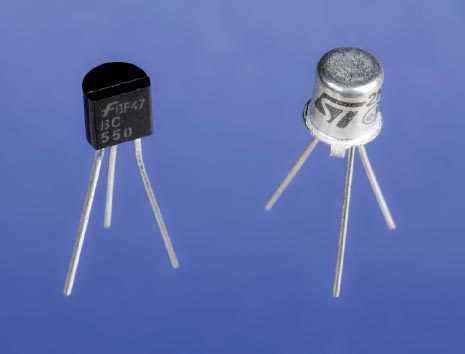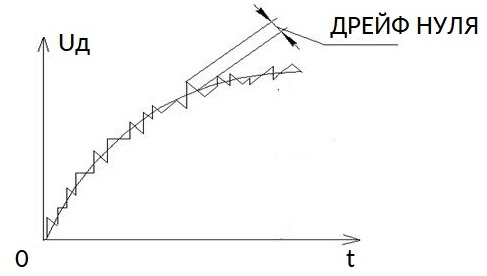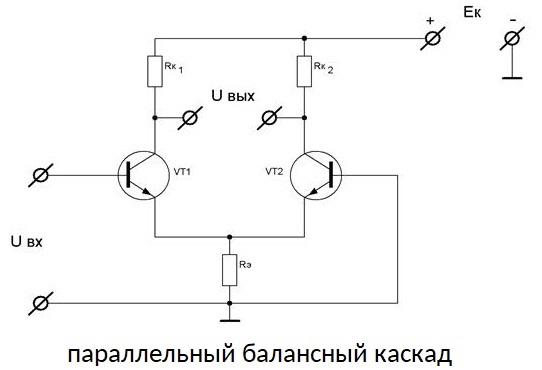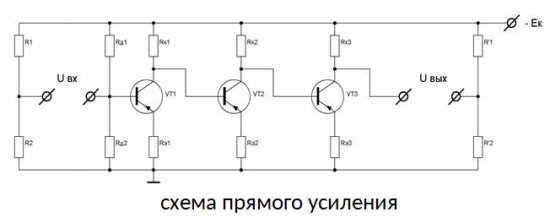DC amplifiers - purpose, types, circuits and principle of operation
DC amplifiers, as the name suggests, do not amplify current per se, that is, they do not generate additional power. These electronic devices are used to control electrical vibrations in a certain frequency range starting from 0 Hz. But looking at the shape of the signals at the input and output of the DC amplifier, it can be unequivocally said that there is an amplified input signal at the output, but the power sources for the input and output signals are individual.
According to the principle of operation, DC amplifiers are classified into direct amplifiers and converter amplifiers.
DC conversion amplifiers convert DC to AC, then amplify and rectify. This is called gain with modulation and demodulation — MDM.

Direct amplifier circuits do not contain reactive elements, such as inductors and capacitors, whose impedance is frequency dependent. Instead, there is a direct galvanic connection of the output (collector or anode) of the amplifier element of one stage to the input (base or grid) of the next stage.For this reason, a direct gain amplifier is able to pass (amplify) even D.C.… Such schemes are also popular in acoustics.

However, although the direct galvanic connection transfers very accurately between the voltage drop of the stages and slow current changes, such a solution is associated with unstable operation of the amplifier, with difficulties in establishing the operating mode of the amplifier element.
When the voltage of the power supplies changes slightly, or the mode of operation of the amplifier elements changes, or their parameters float a little, then slow changes in the currents in the circuit are immediately observed, which through galvanically connected circuits enter the input signal and accordingly distort the shape of signal at the output. Often these spurious output changes are similar in magnitude to the performance changes caused by a normal input signal.

Output voltage distortion can be caused by a variety of factors. First of all, through internal processes in the chain elements. Unstable voltage of power supplies, unstable parameters of passive and active elements of the circuit, especially under the influence of temperature drops, etc. They may not be related to the input voltage at all.
Changes in the output voltage caused by these factors are called amplifier null drift. The maximum change in the output voltage in the absence of an input signal to the amplifier (when the input is closed) over a period of time is called the absolute drift.
The drift voltage referred to the input is equal to the ratio of the absolute drift to the gain of the given amplifier.This voltage determines the sensitivity of the amplifier as it limits the minimum detectable input signal.
For an amplifier to operate properly, the drift voltage must not exceed a predetermined minimum voltage of the signal to be amplified that is applied to its input. If the output drift is of the same order as or exceeds the input signal, the distortion will exceed the allowable limit for the amplifier, and its operating point will be shifted out of the adequate operating range of the amplifier's characteristics («zero drift»).
To reduce the zero deviation, the following methods are used. First, all voltage and current sources feeding the amplifier stages are stabilized. Second, they use deep negative feedback. Third, temperature drift compensation schemes are used by adding nonlinear elements whose parameters depend on temperature. Fourth, balancing bridge circuits are used. Finally, the direct current is converted to alternating current, after which the alternating current is amplified and rectified.
When creating a DC amplifier circuit, it is very important to match the potentials at the input of the amplifier, at the connection points of its stages, as well as at the output of the load. It is also necessary to ensure the stability of the stages in different modes and even in conditions of floating circuit parameters.
DC amplifiers are single-ended and push-pull. One-shot direct gain circuits accept the direct feeding of the output signal from one element to the input of the next.The collector voltage of the first is fed to the input of the next transistor together with the output signal from the first element (transistor).
Here the potentials of the collector of the first and the base of the second transistor must be matched, for which the collector voltage of the first transistor is compensated by a resistor. A resistor is also added to the emitter circuit of the second transistor to offset the base emitter voltage. The potentials on the collectors of the transistors of the subsequent stages must also be high, which is also achieved by using matching resistors.

In a parallel balanced push stage, the resistors of the collector circuits and the internal resistances of the transistors form a four-arm bridge, one of the diagonals of which (between the collector-emitter circuits) is supplied with a supply voltage, and the other (between the collectors) is connected to the load . The signal to be amplified is applied to the bases of both transistors.
With equal collector resistors and perfectly identical transistors, the potential difference between the collectors, in the absence of an input signal, is zero. If the input signal is nonzero, then the collectors will have potential steps equal in magnitude but opposite in sign. The load between the collectors will appear alternating current in the form of a repeating input signal, but with a larger amplitude.
Such stages are often used as primary stages of multistage amplifiers or as output stages to obtain balanced voltage and current. The advantage of these solutions is that the effect of temperature on both arms changes their characteristics equally and the output voltage does not float.

